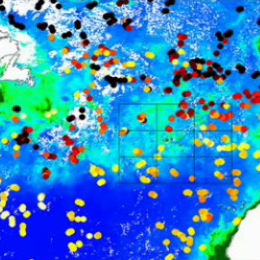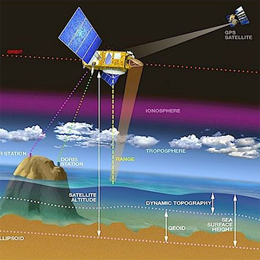Satellite skills and knowledge for operational meteorologist
Listed here are other resources related to Satellite skills and knowledge for operational meteorologist tag:
Note: click on an image to open the Resource
A weather front is a boundary separating two masses of air of different temperatures and humidity, thus different densities.
A weather front is a boundary separating two masses of air of different temperatures and humidity, thus different densities. They are often connected to a significant phenomenon such as showers and thunderstorms, and more generally to instability of the atmosphere. This lecture is based on two frontal structure types - Cold and a Warm font. In Satmanu there are five types or conceptual models related to Cold front; Arctic Cold Front, Cold Front (divided into Ana and Kata types), Cold Front in Cold Advection, Cold Front in Warm Advection and a Split front. Among Warm Front features there are; Detached Warm Front, Warm Front Band and a Warm Front Shield. In Satrep manual there are five chapters on each of above mentioned features; Cloud Structure in Satellite Images, Meteorological Physical Background, Key Parameters, Typical Appearance in Vertical Cross Sections and Weather Events. Ab Maas, will try to introduce these chapters to you, dealing with above mentioned types of Cold and Warm fronts.
Presentation on how do occlusion cloud bands look like in different satellite images and which processes take place in the troposphere that lead to what we see.
This lecture is somehow extension of previous lecture in the satellite course, and is given by Dr. Veronika Zwatz-Meise. She is speaking about Occlusions. There are five features connected to them and these are; Back-Bent Occlusion, Cold Air Development, Instant Occlusion, Cold Conveyor Belt Type and a Warm Conveyor Belt Type of Occlusion. Presentation is constructed in a way that first there is an explanation of how do occlusion cloud bands look like in different satellite images. Question of processes that take place in the troposphere that lead to what we see in satellite images is also discussed. After that meteorological numerical parameters that describe the occlusion processes in a best way are observed (both on isobaric and isentropic surfaces). And at the end answer to a question "Which special developments at/with occlusion cloud bands take place during their life cycle?" are answered.
Presentation on the substructures in fronts and initial stages of cyclogenesis.
This one hour presentation on Frontal Structures, brought by Andreas Wirth from ZAMG, is following content of chapter called "Substructures in fronts and initial stages of cyclogenesis", from Satmanu manual. But not all features under this chapter will be discussed. Lecture starts with Front Decay and Front Intensification by Jet Crossing. These are two very similar conceptual models but they show the opposite effect. This is followed by Upper Wave and Wave. Presenter will show these two conceptual models together to see the differences or the common features between them. Finally, presentation finishes with Secondary Low Centres in Occlusion Cloud Bands, which is feature easy to detect and not very complicated conceptual model.
Sea surface temperature (SST), defined as one of the essential climate variables, has a key role in climate research and weather prediction by representing the boundary condition for both the ocean and the atmosphere.
Sea surface temperature (SST), defined as one of the essential climate variables, has a key role in climate research and weather prediction by representing the boundary condition for both the ocean and the atmosphere.
This presentation shows how the SST is retrieved from satellite observations and its main retrieval errors, the instruments and satellites used in its retrieval and the main SST applications. At the end, a brief overview of the future satellite SST-related missions is given.
Scatterometer winds are used by all major NWP centres and by the oceanographic community. At KNMI high resolution ASCAT scatterometer data is assimilated in the NWP High-Resolution Limited Area Model (HiRLAM).
Over the last years the processing of ERS scatterometer winds has been refined. Subsequently, High Resolution Limited Area Model, HIRLAM, and ECMWF model data assimilation experiments have been carried out to assess the impact of one scatterometer, ERS-1 and of two scatterometers, ERS-1 and ERS-2, on the analyses and forecasts. We found that scatterometer winds have a clear and beneficial impact in the data assimilation cycle and on the forecasts. Furthermore, ECMWF has shown that ERS scatterometer data improve the prediction of tropical cyclones in 4Dvar, where unprecedented skillful medium-range forecasts result of potential large social-economic value. Nevertheless, scatterometer winds contain much sub-synoptic scale information where the smallest scales resolved are difficult to assimilate into a Numerical Weather Prediction, NWP, model. This is mainly due to the otherwise general sparsity of the observing system over the ocean. In line with this it is found that scatterometer data coverage is very important for obtaining a large impact. In that respect future scatterometer systems such as SeaWinds on QuikSCAT and ADEOSII, and ASCAT on EPS are promising.
Satellite based scatterometers provide high resolution all-weather wind vector fields over the seas. Wind speed and wind direction are provided at high accuracy under all weather conditions.
Scatterometers uniquely define the mesoscale wind vector field at the sea surface by measuring the radar backscatter signal from wind-generated cm-sized, so-called gravity-capillary sea waves. Because of the wavelength (5 cm), the signal of ASCAT is not affected by rain, and is therefore an "all-weather" system.
The all-weather capability of the ASCAT scatterometer provides unique wind field products of the most intense and often cloud-covered wind phenomena, such as polar front disturbances and tropical cyclones. As such, it has been demonstrated that scatterometer winds are extremely useful in the prediction of extra-tropical and tropical cyclone). Moreover, high-resolution near-surface winds as provided by scatterometers are very relevant because these winds drive the ocean water circulation, which in turn plays a major role in the climate system and in marine life and its exploitation (e.g., fishery).
Presentation about satellite images of phytoplankton chlorophyll in the North Atlantic.
Presentation about satellite images of phytoplankton chlorophyll in the North Atlantic. André Valente introduces how phytoplankton chlorophyll is measured from space, describing the spatial and temporal patterns observed in the satellite images and identify the physical processes responsible for the observed variability.
The most important light-absorbing substance in the oceans is chlorophyll, which phytoplankton use to produce carbon by photosynthesis. Due to this green pigment - chlorophyll - phytoplankton preferentially absorb the red and blue portions of the light spectrum (for photosynthesis) and reflect green light. So, the ocean over regions with high concentrations of phytoplankton will appear as certain shades, from blue-green to green, depending upon the type and density of the phytoplankton population there. The basic principle behind the remote sensing of ocean color from space is this: the more phytoplankton in the water, the greener it is....the less phytoplankton, the bluer it is.
Presentation on Rapid Cyclogenesis and Instant Occlusion.
Two conceptual models from Satmanu manual are introduced by Barbara Zeiner from ZAMG; Rapid Cyclogenesis and Instant Occlusion. These are two kinds of cyclogenesis, but not the classical forms of an occlusion. In normal or classical occlusion there would be a broken wave in a polar front, but in this case we have somewhat different situation. In short, Rapid Cyclogenesis describes a very fast and intensive development of an Occlusion cloud spiral from a low level cloud head. Upper air processes are driving factors in such a development. On the other hand, Front intensification by jet crossing is development of thicker and mostly more convective cloud within a frontal cloud band in the left exit region of a jet streak during frontal crossing. All these processes in this lecture are supported by satellite images and lot of schematics from Satmanu Manual.
Sea surface height variation and mean sea level applications from radar altimetry.
Radar altimetry satellites have been measuring the whole Earth’s ocean since 1991. Currently Jason-2, Envisat and Jason-1 are operational. Their main objective is the measurement of sea surface height variations. With a twenty-years long time series, the possibilities for climate studies are wide. We will describe roughly the data processing and uses, but mostly insist on two different applications:
Retrieval of wave parameters with Altimeter; Wind and wave from radar altimetry satellites: measurements and uses.
Radar altimetry satellites have been measuring the Earth’s ocean since 1991. Currently Jason-2, Envisat and Jason-1 are operational. If the main objective of those are the measurement of sea surface height, wind speed (modulus) and significant wave heights are very useful - bonuses - to these techniques. The presentation will explain how these quantities are retrieved from the altimeter measurements, and how they are used in meteorology, climatology and oceanography.
Presentation on SAR image analysis and on the interpretation of oceanic and atmospheric phenomena, with examples of signatures of downbursts, convective cells and sea/land breezes. Also, the retrieval of high resolution wind speed with SAR will be addressed.
Synthetic-aperture radar (SAR) is a form of radar whose defining characteristic is its use of relative motion between an antenna and its target region to provide distinctive long-term coherent-signal variations that are exploited to obtain finer spatial resolution than is possible with conventional beam-scanning means. It originated as an advanced form of side-looking airborne radar (SLAR).
SAR is usually implemented by mounting, on a moving platform such as an aircraft or spacecraft, a single beam-forming antenna from which a target scene is repeatedly illuminated with pulses of radio waves at wavelengths anywhere from a meter down to millimeters. The many echo waveforms received successively at the different antenna positions are coherently detected and stored and then post-processed together to resolve elements in an image of the target region.
Current airborne systems provide resolutions to about 10 cm, ultra-wideband systems provide resolutions of a few millimeters, and experimental terahertz SAR has provided sub-millimeter resolution in the laboratory.
SAR images have wide applications in remote sensing and mapping of the surfaces. In this presentation the applications for monitoring the ocean surfaces are discussed.
This lecture is about conceptual models connected to strong convective processes.
This lecture is about conceptual models connected to strong convective processes. For easier detection and understanding of these clusters, Key parameters are introduced. Most of times there is (Equivalent) Thickness (e.g between 1000 and 500hPa) given along with Potential (Wet Bulb) Temperature at 850 hPa, and together they present parameters for detection of warm areas in Troposphere suitable for convective processes. Low Level Convergence is a key parameter used for detection of areas of high convergence, thus triggering convective areas. Of course, Instability indices are given to track the areas of unstable atmosphere also suitable for cloud development. Some of the physical background and examples of convective processes is shown it this lecture, with help of Satmanu module and satellite images. Also one of the convective cloud features known as a Spanish Plume is descirbed, along with four main types of thunderstorms (Single call, Multicell cluster, Multicell line and Supercell). Presenter of this lecture is Frans Debie, from KNMI.












